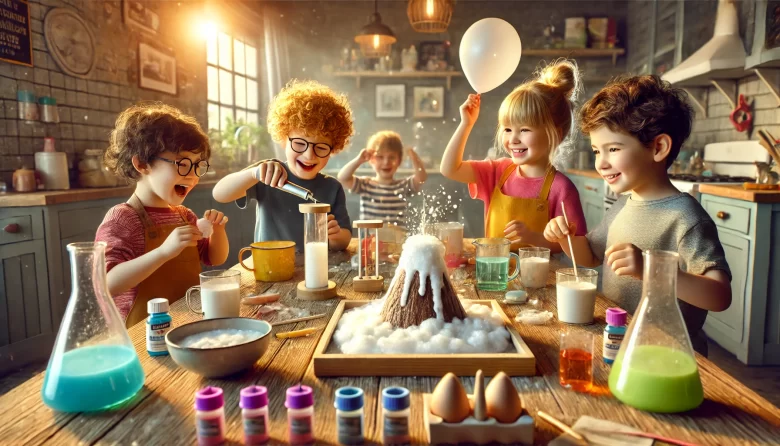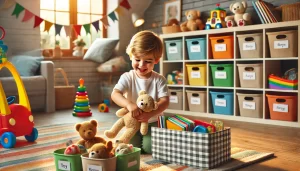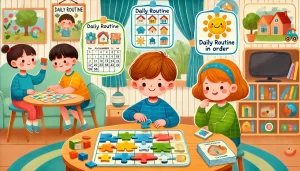Science is a world of wonders, and young children are naturally curious about how things work. Engaging in simple experiments at home not only makes learning fun but also encourages problem-solving, observation skills, and critical thinking.
Here, we’ll explore exciting science experiments that use everyday household items. These hands-on activities will keep your little ones entertained while fostering a love for discovery!
Magic Milk Experiment – Exploring Color Mixing and Chemistry
This experiment is a visual delight and a great way to introduce kids to chemistry!
What You’ll Need:
- A shallow plate
- Whole milk
- Food coloring (various colors)
- Dish soap
- A cotton swab
How to Do It:
- Pour enough milk into the plate to cover the bottom.
- Add a few drops of different food colorings across the surface of the milk.
- Dip the cotton swab in dish soap and gently touch the milk’s surface.
- Watch as the colors swirl and mix in mesmerizing patterns!
Why It Works:
The dish soap breaks down fat molecules in the milk, causing the colors to move around as the soap interacts with them.
Baking Soda and Vinegar Volcano – An Explosive Chemical Reaction
This is a classic experiment that never fails to amaze kids!
What You’ll Need:
- A small plastic cup
- Baking soda (2 tablespoons)
- Vinegar (½ cup)
- Dish soap (optional, for extra foaming)
- Red food coloring (for a lava effect)
How to Do It:
- Place the plastic cup on a tray to catch any spills.
- Add the baking soda to the cup.
- Mix a few drops of food coloring and dish soap into the vinegar.
- Pour the vinegar into the cup and watch it erupt like a volcano!
Why It Works:
Baking soda (a base) reacts with vinegar (an acid) to produce carbon dioxide gas, creating a foamy eruption.
Dancing Raisins – A Lesson in Buoyancy
This experiment demonstrates how gas bubbles affect buoyancy in liquids.
What You’ll Need:
- A clear glass
- Carbonated water (or any fizzy drink)
- A few raisins
How to Do It:
- Fill the glass with carbonated water.
- Drop in a few raisins and observe.
- The raisins will begin to “dance” up and down!
Why It Works:
The carbon dioxide bubbles attach to the raisins, making them rise. When the bubbles pop, the raisins sink back down.
Walking Water Experiment – Capillary Action in Action!
This experiment shows how water can move through materials, just like plants absorb water from the soil.
What You’ll Need:
- 6 clear cups
- Water
- Paper towels
- Food coloring (red, yellow, and blue)
How to Do It:
- Fill three cups with water and leave the other three empty.
- Add a few drops of red, yellow, and blue food coloring to the filled cups.
- Arrange the cups in a circle, alternating filled and empty cups.
- Fold paper towels into strips and place one end in a full cup and the other in an empty cup.
- Watch as the water “walks” through the paper towels and fills the empty cups, creating new colors!
Why It Works:
The paper towels absorb and transport water through capillary action, which is the same way plants draw water up from their roots.
Invisible Ink with Lemon Juice – Secret Messages
Kids love secret codes! This experiment lets them write messages that can only be revealed with heat.
What You’ll Need:
- Lemon juice
- Cotton swabs or a paintbrush
- White paper
- A heat source (lamp, iron, or candle)
How to Do It:
- Squeeze lemon juice into a small bowl.
- Dip the cotton swab into the juice and use it to write a message on the paper.
- Let the paper dry completely.
- Hold the paper near a heat source (like a lamp or candle, with adult supervision).
- The writing will magically appear!
Why It Works:
Lemon juice oxidizes and turns brown when exposed to heat, revealing the hidden message.
Static Electricity Butterfly – Learning About Electrical Charges
This fun craft experiment teaches kids about static electricity.
What You’ll Need:
- Tissue paper
- Construction paper
- A balloon
- Scissors
- Glue
How to Do It:
- Cut out a butterfly shape from the construction paper.
- Cut out a smaller butterfly from tissue paper and glue only its center onto the construction paper.
- Blow up the balloon and rub it on your hair to generate static electricity.
- Hold the balloon near the tissue-paper wings.
- Watch the wings lift and move as if the butterfly is flapping!
Why It Works:
The balloon transfers electrons, creating static electricity that attracts the lightweight tissue paper.
Homemade Slime – A Fun Polymers Experiment
This gooey experiment is a favorite among kids and helps them understand the science of polymers.
What You’ll Need:
- ½ cup white glue
- ½ cup water
- Food coloring (optional)
- ½ teaspoon baking soda
- 1 tablespoon contact lens solution
How to Do It:
- Mix glue and water in a bowl.
- Add food coloring if desired.
- Stir in baking soda.
- Add contact lens solution and mix until the slime forms.
- Knead it until it’s stretchy and fun to play with!
Why It Works:
The glue contains polymers that link together when mixed with baking soda and contact lens solution, creating the stretchy slime texture.
Final Thoughts
Science experiments at home are an exciting way to introduce children to the magic of learning. These simple activities not only spark curiosity but also build foundational scientific knowledge in a fun and engaging way.
Encourage your little scientists to ask questions, make observations, and predict outcomes. With these hands-on experiments, learning becomes an adventure full of surprises!




